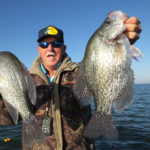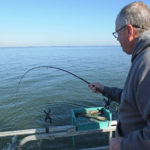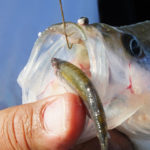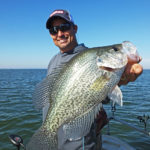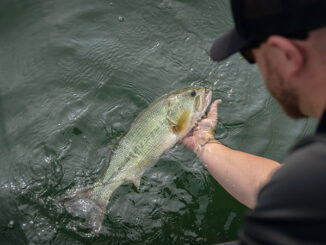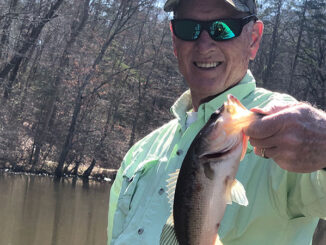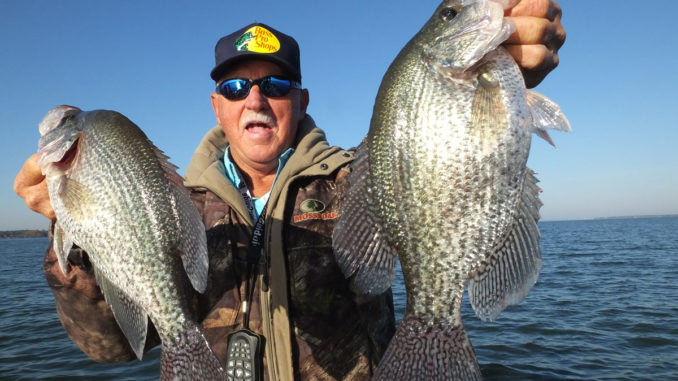
The spawn may be at hand, but one guide on South Carolina’s Santee Cooper lakes said deep water may be the ticket to some of the best crappie fishign of the year.
Early spring and crappie fishing form a perfect combination of potential and realization on the Santee Cooper lakes. If you’re looking for a heavy stringer, they are legendary for producing huge crappie, and it helps that March is prime time for roe-laden slabs to be on a strong bite while shifting from prespawn to the spawning.
The key is finding and staying on the ever-changing patterns.
Guide David Hilton of Ridgeville, S.C., fishes for multiple species on the Santee Cooper lakes, but in March, he targets slab crappie.
“The trick in March is not if the crappies will bite — they will bite — it’s staying on a productive pattern, because crappies are a moving target,” Hilton said. “Because of their tendency to move during the prespawn and spawn, my strategy is, if fish don’t bite quickly at a place, I’m on the move to another spot and often to different water depths.”
Hilton routinely fishes both lakes, working out of Blacks Camp on the Diversion Canal and Lake Moultrie and Bells Marina on Lake Marion.
“Both lakes are excellent in March and I’ll often make the decision on specifically where to fish based on daily wind and weather patterns,” he said. “For crappie-fishing success, boat control is a primary focus.”
Hilton said depending on weather patterns and the time of the month anglers may find crappie in various depths.
“I look for places where they congregate in big numbers to enhance my odds for high success,” Hilton said. “Much of my effort is in deep water over brush piles, leaning trees and other woody objects. I specifically want the cover to be around humps, drops and channel ledges. On these type places, I expect to catch multiple fish at any given time.”
Hilton said that shallow-water fishing for spawning fish can be very good during March and into April. When crappie get into the spawning mode, some will move to shallow water, and anglers can target them by fishing shallow trees, stumps, downed logs and shallow brush.
“When they spawn, crappie will get into coves in 3 to 5 feet of water around woody cover,” he said. “Many of the black crappie will spawn in the shallows, but I’ve found that many white crappies will spawn on the brush piles in deeper water. When the water temperature gets to about 58 degrees, they begin a move to the shallows to spawn.”
Hilton said not all the fish go shallow, and certainly not at the same time. This type fishing is primarily hunting single fish around isolated targets.
“Shallow fishing can be good if conditions are ideal, but it’s often dramatically impacted by cold fronts,” Hilton said. “Fishing deep-water cover vastly reduces the impact of cold fronts on the crappie bite, and that’s why it’s my preference; it’s consistent.
“I prefer deep cover because the fish still bite,” he said. “But on pre-frontal days after a warming trend crappie will usually get very active,” he said. “I’ll mark them on the graph over and along the sides of the brush or cover. These fish are often aggressive and catching multiple fish from any given spot is very likely. ”
Hilton said the best depths during March will vary depending on water temperature and weather conditions.
“As a general guideline, fish hold a bit deeper early in the month because the water is colder,” he said. “If we’ve had a cold winter, crappie may be 25 to 30 feet deep in late-February and early March. But by the end of the month, I’m usually working the 14- to 15-foot depths. As the water temperature rises, the crappie get incrementally shallower, so I’ve got to constantly adjust my depth.”
“When I find them, the potential to catch a limit of slabs is high,” he said. “They’re very willing to bite, but fishermen need to be prepared to move either to shallower or deeper water. They could be on the top of a hump one day and at the base of it the next trip, or vice versa.”
Hilton said several factors play a role in success, but none more important than the depth fished on any given day. It’s not just the depth of water where the brush is located it’s the precise depth where the fish are suspended over and around a specific target.
“Once I find the right depth, I want to maintain that depth on the line I have out,” he said. “I use 8½-foot Granger fly rods with small baitcasting reels to hold 10-pound test line. I have a 1/0 wire hook and use a No. 3 split-shot about 8 inches above the hook.”
Hilton pulls out line to match the length of the rod, then pulls additional line off the reel in measured increments to place the bait at a specific depth. Then, he swims the bait over the target, holding the rig as still as possible. When he hooks a crappie he doesn’t reel the fish in, he strips line in as if using a fly reel.
“Pull the line in with the left hand if right-handed and simply hold the line in your right fingers and swing the fish aboard,” he said. “Then re-bait and drop the bait back in the water, and it will fall to the exact depth the fish was just caught. Odds are good another crappie will quickly be hooked.”
Electronics play a major role for Hilton; he uses his graph to mark the exact target, then tosses out a floating marker to mark the location. He doesn’t place it directly on top of the brush, but off to the side so he can use it as a reference.
“The marker doesn’t mark the spot to fish; it’s a reference for me, enabling me to keep my presentation consistent,” he said. “I’ll maneuver the boat into the wind and approach the target using my electric motor to maintain the best boat control. I have my fishermen hold the rods in front of the boat as I approach the target and as soon as we begin catching fish I use the reference marker to keep the bait exactly where I want it.
“I have a graph in the front of the boat, but the marker enables me to fine-tune my presentation. As the action slows, I continue to move over and around the brush until we’ve fished it thoroughly. Each time we catch a fish, I’ll use the marker to help me keep the boat on target. When we’ve fished the brush, I’ll retrieve the marker and move.”
Hilton said to simply keep repeating the process until limits are caught.
DESTINATION INFORMATION
HOW TO GET THERE — The Santee Cooper lakes are easily accessed from I-95, I-26 and US 52.. SC 6 is a key route along the south side of both lakes. For specific location of public boat ramps, visit http://www2.dnr.sc.gov/ManagedLands/Boatramp/BoatRampLake
WHEN TO GO — March is a big month on the crappie-fishing calendar year on the Santee Cooper lakes as fish get into a full-blown prespawn mode, with the spawn to follow as soon as the water temperature reaches the high 50s.
BEST TECHNIQUES — Guide Dave Hilton said shallow-water fishing, dipping baits and lures along shallow, shoreline structure, can produce when the spawn is at its peak, but he prefers to fish for prespawn slabs around deeper brush piles, where they will be staging in big numbers. Fish will move from deeper brush to shallower brush as the month progresses, but 14 to 15 feet is an important depth for him. He uses long, limber fly rods and small spincast or baitcast reels spooled with 10-pound test, a No. 3 hook and a small split-shot pinched off above the hook. He likes to fish live minnows. With depth control being so important, he avoids reeling in when a fish is hooked, opting to for a strip retrieve, so when a fish is boated and unhooked, the bait will return to the exact same depth every time.
FISHING INFO/GUIDES — David Hilton, 843-870-4734; Black’s Camp, 843-753-2231, www.blackscamp.com;
ACCOMMODATIONS — Black’s Camp, 843-753-2231, www.blackscamp.com; Santee Cooper Country, 803-854-2131, www.santeecoopercountry.org.
MAPS — Kingfisher Maps, 800-326-0257, www.kfmaps.com.

